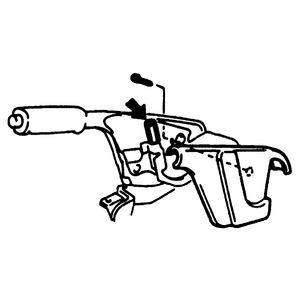| Fig. 1: Adjust the parking brake cable at the lever

|
- Make sure the rear brake shoes are properly adjusted.
- Start the engine and depress the brake pedal several times while the vehicle
is moving in reverse.
- Stop the engine.
- On MPV, remove the screw and remove the parking brake lever cover. Remove
the adjusting nut clip.
- On B Series pickup, loosen the locknut at the end of the front cable, near
the parking brake lever.
- Turn the adjusting nut until the parking brake is fully applied when the
lever is pulled 7–12 notches on B Series pickup or 5–7 notches
on MPV.
- Tighten the locknut on B Series pickup.
- Install the adjusting nut clip and the parking brake lever cover on MPV.
NOTE: Adjust the drum brakes before adjusting the parking brake.
The brake drums must be cold for correct adjustment.
Use this procedure when a new tension limiter is installed.
- Apply the parking brake pedal to the fully engaged position.
- Raise and safely support the vehicle, as necessary. Hold the threaded rod
end of the right brake cable to keep it from spinning and thread the equalizer
nut 2 1⁄2 inches
(63.5mm) up the rod.
- Check to make sure the cinch strap has slipped and there are less than 1 3⁄8 inches
(35mm) remaining.
- Release the parking brake and check for proper operation.
Use this procedure to correct a slack system if a new tension limiter is not
installed.
- Apply the parking brake pedal to the fully engaged position.
- Raise and safely support the vehicle, as necessary. Grip the threaded rod
to keep it from spinning and tighten the equalizer nut 6 full turns past its
original position on the threaded rod.
- Attach a suitable cable tension gauge in front of the equalizer assembly
on the front cable and measure the cable tension. The cable tension should
be 400–600 lbs. (181.5–272 kg) with the parking brake pedal in
the last detent position. If tension is low, repeat Steps 2 and 3.
- Release parking brake and check for rear wheel drag. There should be no
brake drag.

